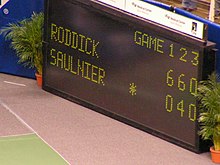 Tennis pictogram | |
| Highest governing body | International Tennis Federation |
|---|---|
| First played | 19th century, Birmingham, England, United Kingdom |
| Characteristics | |
| Contact | No |
| Team members | Singles or doubles |
| Mixed sex | Yes, separate tours and mixed doubles |
| Type | Outdoor or indoor |
| Equipment | Ball, racket, net |
| Venue | Tennis court |
| Glossary | Glossary of tennis terms |
| Presence | |
| Country or region | Worldwide |
| Olympic | Part of Summer Olympic programme from 1896 to 1924 Demonstration sport in the 1968 and 1984 Summer Olympics Part of Summer Olympic programme since 1988 |
| Paralympic | Part of Summer Paralympic programme since 1992 |
| Part of a series of articles on Sports | |
| Summer Sports | |
| Track and field athletics Football (soccer) | |
| Water sports | |
| Martial arts | |
| Net sports | |
| Ice hockey· Skating Skiing·Curling | |





Tennis is a sport played with a felt-covered rubber ball, a tennis racket, and a court.
First, early in the 11th century, players in France played a sport like this with their hands. It was called “Jeu de Paume”. In the 15th century the players played with rackets. Now it is called “tennis”. It became popular in England and France. King Henry III of France was a big fan of the game. This kind of sport is still played but is known as real tennis ("real" here meaning "royal"). The sport of "lawn tennis" played on grass courts was invented in mid 19th-century England and later spread into many other countries.[1][2]
There are many different kinds of courts, like grass, clay or hard court. The goal of tennis is to hit the ball over the net into the other player’s court. When the other player cannot return the ball, a point is won. The game is played with two or four people. When it is played with two people, it is called “singles”, and when it is played with four people, it is called “doubles”. The court has "alleys" on each side, which are "fair" territory when playing doubles.
A tennis game has a number of sets. Each set has a number of games, and each game has points. The points are counted love (0, after the French l'oeuf), fifteen (15), thirty (30), and forty (40). If both players get to forty, the score is deuce from which 2 more points are needed to win the game. When one player reaches six games, it is one set. If it is a three-set match, the player who wins two sets first is the winner. If the game count reaches 5–5, the set must be won with two more games than the other player, like 7–5 or 8–6. If the game count gets to 6–6, a "tiebreaker" is played. In a tiebreak, players have to get at least seven points while getting two more points than the other player to win the set. In tiebreak points are called “one,” “two,” etc.
There is also soft tennis. Soft tennis is different from regulation tennis. For example, the racket, ball and rules are much different. Soft tennis is popular in Japan. Thousands of people play soft tennis. Tennis is quite a popular sport which lots of people enjoy watching.
There are many different "shots" and "strokes", ways to hit the ball, in tennis. A stroke is the way the body is moved to hit the ball. A shot is how the ball is hit. These include:
Tennis is now a sport that is played at the Olympics. They also have big tournaments like the U.S. Open, Australian Open, French Open and Wimbledon. These four are known as Grand Slam events.
Winning all four Grand Slams in the same year is called a Calendar Slam. They are the most important tennis tournaments of each season (year). This is because of the world ranking points, tradition, prize-money, and public attention.[source?]